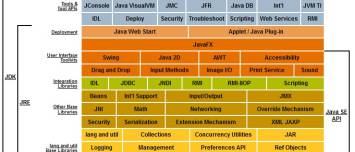About
This interface is a member of the Java Collections Framework.
Set is a collection that cannot contain duplicate elements. This interface models the mathematical set abstraction and is used to represent sets, such as the cards comprising a poker hand, the courses making up a student's schedule, or the processes running on a machine.
See java.util.Set
Using a HashSet, contains is a constant-time operation. This is much better than a linear search through an array.
Restrictions / Prerequisites
- The Set collection doesn't allow duplicate and use the equals and hashCode methods to ensure this integrity. This methods must be then implemented in the element of your collection.
- It is not permissible for a set to contain itself as an element.
- The behaviour of a set is not specified with mutable objects as element. (If the value of an object is changed in a manner that affects equals comparisons).
Methods
Basic Methods
int size();
boolean isEmpty();
boolean contains(Object element);
boolean add(E element); // optional
boolean remove(Object element); // optional
Iterator<E> iterator();
Bulk Methods
boolean containsAll(Collection<?> c);
boolean addAll(Collection<? extends E> c); // optional
boolean removeAll(Collection<?> c); // optional
boolean retainAll(Collection<?> c); // optional
void clear(); // optional
Array Methods
Object[] toArray();
<T> T[] toArray(T[] a);
Management
Creation
New
The Java platform contains three general-purpose Set implementations:
It stores its elements in a hash table, is the best-performing implementation; however it makes no guarantees concerning the order of iteration.
Set<String> myHashSetMap= new HashSet<String>();
// or with a initial set
Set<String> set = new HashSet<>(Arrays.asList("first element"));
// or
Stream.of("a", "b").collect(Collectors.toSet());
- TreeSet,
It stores its elements in a red-black tree, orders its elements based on their values; it is substantially slower than HashSet.
- LinkedHashSet.
It is implemented as a hash table with a linked list running through it, orders its elements based on the order in which they were inserted into the set (insertion-order). LinkedHashSet spares its clients from the unspecified, generally chaotic ordering provided by HashSet at a cost that is only slightly higher.
- SortedSet
a Set that maintains its elements in ascending order. Several additional operations are provided to take advantage of the ordering. Sorted sets are used for naturally ordered sets, such as word lists and membership rolls.
From Stream with a constructor
- Collectors.toSet() for a HashSet
mySet = Arrays.stream(conf.split(","))
.map(String::trim)
.collect(Collectors.toSet());
- For a specific set, Collectors.toCollection
mySet = Arrays.stream(conf.split(","))
.map(String::trim)
.collect(Collectors.toCollection(SetKeyIndependent::new));
Remove a key
mySet.remove(myKeyObject)
To list
- from list instantiation
List<T> ts = new ArrayList<T>(mySet);
//or
List<T> ts = new ArrayList<T>();
ts.addAll(mySet)
- from Stream
List<String> list = set.stream().collect(Collectors.toList());
How to
Get no Duplicate in a set
As a Set which, by definition, cannot contain a duplicate, the function works by using the standard conversion constructor described in the The Collection Interface section.
The equals and hashCode methods must be implemented.
If you have a Collection c where you want to eliminate all duplicates.
- In on line
Collection<Type> noDups = new HashSet<Type>(c);
// of to preserve the order of the original collection
Collection<Type> noDups = new LinkedHashSet<Type>(c);
- With a method:
public static <E> Set<E> removeDups(Collection<E> c) {
return new LinkedHashSet<E>(c);
}
